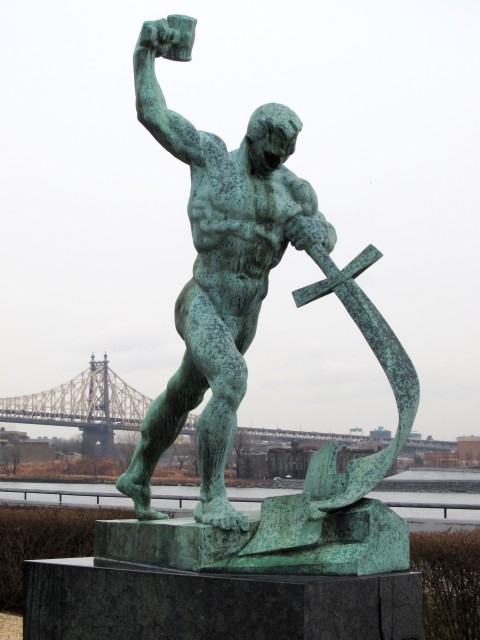How evil wins, and how to beat it
We need to study peace a lot harder than those who are studying war.

If the first casualty of war is truth, perhaps the first casualty of political disappointment is a sense of proportion. If people had been in the habit of sending Christmas circular letters in 1917 or 1942, they could hardly have begun with a gloomier first paragraph than the ones I received from the United States and the United Kingdom at the end of last year.
Looking for balance between what’s wrong and what could be a lot worse, I decided to visit Auschwitz-Birkenau in January.
Auschwitz is the epitome of World War II. It was originally a Polish military camp. When western Poland was annexed by Germany, Auschwitz became an internment camp for Polish elites and political prisoners. When the Final Solution was decided upon and the extinction of European Jewry was planned in earnest, the camp began to kill people in two ways: a minority worked in hideous conditions until they dropped dead—after around two months in most cases. The majority, 700 at a time, went to the gas chamber. Five other extermination camps were opened, all in what had been western Poland, but Auschwitz was overstretched, so a second camp, Auschwitz-Birkenau, opened two miles away. Each of its four gas chambers could kill 2,000 people at a time. Railroads brought people in overcrowded carriages right into the camp. When the train emptied, 20 percent of the occupants were directed to the workers’ quarters, and the rest walked half a mile down the platform and into the gas chambers.
The scale of the project is breathtaking (World War II had plenty of big numbers). Around 1.3 million people died at Auschwitz. Another 3.7 million died at five other death camps, and another 2 million Jews were killed in other ways. More disturbing even than the scale of the atrocity is the planning. Up to 90,000 people inhabited Auschwitz-Birkenau at any one time, and another 20,000 were kept at the original camp. The organization and the detail in the record keeping are remarkable. Cruelty was matched only by efficiency: Jews were told they could bring 25 kilograms of goods to help them start their new life in the East, but their baggage was looted shortly after they discovered the horrifying truth of where they had arrived. Even the hairs on their head were preserved for the war effort. Their gold teeth were extracted, and the ashes of their incinerated bodies fertilized the fields.
I had often wondered why Nazis used gas to achieve their grisly purposes. After visiting the camp, I knew: by giving every prisoner a number, the inmates were dehumanized; by killing them in a sealed chamber, the murderers did not have to watch their victims die, still less meet their eyes; and by using chemicals, the bodies could be disposed of relatively straightforwardly despite the enormous numbers. If soldiers had simply machine-gunned people in the ghettos, none of these things would have been the case.
People often quote political commentator Edmund Burke in his letter to Thomas Mercer: “The only thing necessary for the triumph of evil is for good men to do nothing.” His words are widely taken as a call to activism. But the lesson of Auschwitz is that if one is to achieve good, one must work with even greater attention to detail than those who devise evil. We may blithely say, “I ain’t gonna study war no more,” but what we really need to do is to study peace a lot harder than those who are studying war.
Burke knew this:
Whilst [people] are linked together, they easily and speedily communicate the alarm of any evil design. They are enabled to fathom it with common counsel, and to oppose it with united strength. Whereas, when they lie dispersed, without concert, order, or discipline, communication is uncertain, counsel difficult, and resistance impracticable. Where [people] are not acquainted with each other’s principles, nor experienced in each other’s talents, nor at all practised in their mutual habitudes and dispositions by joint efforts in business; no personal confidence, no friendship, no common interest, subsisting among them; it is evidently impossible that they can act a public part with uniformity, perseverance, or efficacy. . . . When bad [people] combine, the good must associate; else they will fall, one by one, an unpitied sacrifice in a contemptible struggle.
Popular images of desultory social forces today focus on unpleasant sound bites, demeaning remarks, outrageous tweets, and intolerant attitudes. But the Holocaust was about exhaustive preparation, painstaking detail, and astonishing organization. There was nothing reckless, narcissistic, or cavalier about it.
Burke’s words could appropriately be sent to anyone who thinks one can be a Christian without the church, a right-thinker without political association, a Christmas-letter lamenter without sustained coalition building with friend and stranger. If good people are to triumph over evil, they must never underestimate the energy of their enemies. They must rely not simply on the rightness of their cause or the faithfulness of their implementation, but on the relentlessness of detailed planning.
A version of this article appears in the March 29 print edition under the title “How evils wins.”





